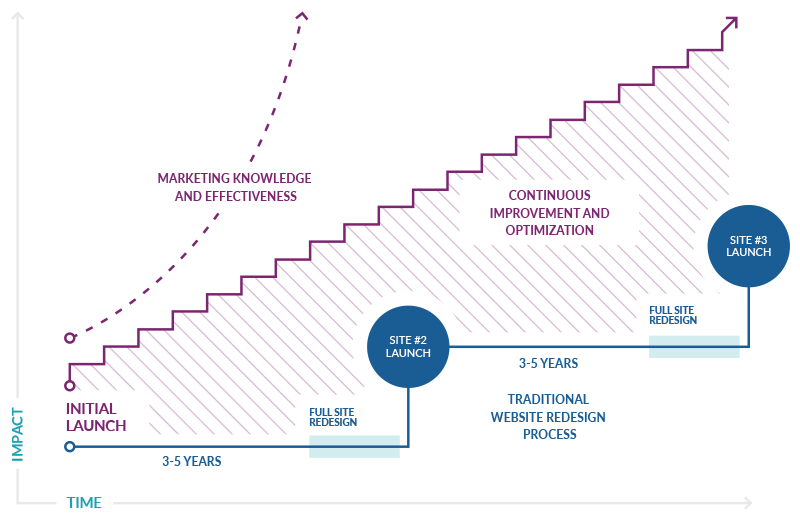Websites need to align with a business’s strategy and brand. They need to provide the type of user-friendly experience expected by modern website visitors. And, they need to perform at a high level to reach marketing and sales goals. When a website fails to meet these requirements, it’s time for a change. In many cases, it’s time for a full website redesign.
Most businesses have come to accept that they’ll need to go through a redesign process once every few years. They may not be happy about it, but they know regular website revamps are necessary to stay current and competitive.
A traditional website redesign process may not always be the best available solution, though. In the right situation, groups should adopt a website continuous improvement approach, instead.
Problems With Traditional Website Redesign Projects
Staying the Same, or Making Things Worse
Before we go further, I want to make it clear that I’m not suggesting traditional website redesign projects—in which teams design and build a new website as part of a single project—are inherently bad. In fact, based on a business’s goals or situation, a full redesign may be needed.
Yes, studies have shown a general lack of satisfaction associated with web design project outcomes. Some studies have even shown a significant percentage of businesses that felt like their project made things worse. Worse!
If you’re a business owner or marketing leader, you’re probably feeling queasy at the notion of making a significant investment only to have your site end up in worse condition.
These studies, however, don’t mean traditional web design projects are bad. What they do show is that only a small number of projects are planned, managed, designed, and built correctly.
Only a certain percentage of redesign projects are planned, managed, designed, and built correctly.
To be successful, a redesign project must mesh the goals of the business with the needs of its target audience. To achieve this outcome, projects must be informed by research and data analysis. Without this work, you end up in the “unhappy” or “worse” categories.
That’s why we include these steps in our own web design process. And, that’s why our full website redesign projects are successful for our clients.
Waiting To Achieve Business Goals
The real problem is that research and analysis—and all of the other work that ensures project success—takes time. Most website projects take 3-6 months to complete, and larger, more complex projects can stretch well beyond that timeline.
These long projects impact businesses and marketing teams in multiple ways.
For one thing, they require time from project team members. Even if a business hires web designers to develop a website, a well-run project will include client team members. They’ll participate in strategy sessions, subject-matter interviews, and creative reviews of page content, design, and experience.
This work takes time and energy. So, it’s only natural that team members may neglect a company’s existing website during the project. They may keep up with basic site maintenance and updates, but they’ll put larger, strategic improvements on hold since those things will be addressed by the new website.
Unfortunately, this means that some strategic improvements may be put on hold for 3-6 months, or more. Whether these improvements relate to search engine optimization, user experience, content strategy, accessibility, or something else, businesses must wait to reap the benefits.
The False “Finish Line” Mindset
Long projects also have a tendency to create a false finish line at the website launch date. A lot of work goes into the design and development of a website. So, design teams should celebrate a successful launch.
The notion that the launch means the end of the work, however, is misleading. In fact, it may even be harmful to ongoing digital marketing performance.
Businesses that launch their new website and move on to other priorities run the risk of significantly limiting the potential value of their new investment.
No matter how well-crafted a website may be at launch, there are always opportunities to make things better. To be successful, modern business websites require attention and optimization. And, that requires ongoing commitment.
Web teams should publish fresh content on a regular basis. They should monitor user behaviors to inform site adjustments. They should run SEO, UX, and accessibility audits to identify issues and refine performance. And, they should test landing page templates to identify conversion improvement opportunities.
Businesses that launch their new website and move on to other priorities—and away from website improvements—run the risk of significantly limiting the potential value of their new investment.
The Website Continuous Improvement Model
So, what’s the alternative? In the right circumstances, teams can achieve better results in a shorter time by focusing on current website improvements. This work is managed through a continuous improvement process that replaces a full website redesign.
What Is Website Continuous Improvement?
Website continuous improvement is an ongoing, agile approach to improving existing website performance through strategic, data-driven changes. These changes can touch on any potential element that impacts website performance (e.g., content, design, navigation, functionality, accessibility, etc.). Through this approach, a website team prioritizes site changes based on a company’s goals and greatest areas of need. The team then implements and measures the changes in a series of sprints.
How Does the Continuous Improvement Cycle Work?
The specific details of continuous improvement execution will look different from one website to the next, but the basic process follows a relatively simple structure.
- Assess: Conduct an initial assessment of the current website to analyze performance and identify critical problem areas.
- Plan: Develop a continuous improvement roadmap to define priorities, SMART goals, tasks, and schedules.
- Implement: Implement priority website changes and tests in sprints.
- Review: Review results in regular website performance analysis sessions using data from Google Analytics and other website analytics platforms.
- Inform: Use analysis insights to inform further improvements and strategic direction.
- Repeat: Repeat steps 1-5, honing in on specific areas of importance through additional audits and updates.
Why Is Website Continuous Improvement Effective?
Because continuous improvement offers an agile approach to improving an existing website, it enables businesses to move quickly.
While businesses going through a traditional redesign process may have to wait several months before feeling the positive impact of their work, a business using continuous improvement can start making changes immediately.
Through continuous improvement, teams can take action to ensure their site is search engine optimized. They can refine their code to improve page load speed and make web page templates more mobile-friendly. They can identify and work through all of the things that limit their site’s performance. And, they can do all of this in a smart, systematic process.
The nimble, data-driven nature of this work also fosters an iterative testing mindset. If a team has a hypothesis about something that can be improved, they can set up a test, run it, and review results in a sprint. Even if their idea proves to be wrong, they’ve gained valuable insights that can inform future website and marketing decisions.
These site changes and tests result in steadily improving website performance and steadily increasing marketing intelligence. While a well-run traditional website project should result in improved performance, without the support of additional digital marketing or continuous improvement work, the improvement will plateau until the next redesign project.
In other words, as the name suggests, a website continuous improvement approach continually makes things better.

Choosing the Right Website Redesign Approach for Your Business
Given the benefits we’ve discussed, it may seem reasonable to think that businesses should always opt for a continuous improvement approach over a traditional web design approach. The reality, though, isn’t quite that simple.
Before choosing an approach, it’s important to understand your goals and your situation.
When Is Continuous Improvement the Right Approach?
Situation #1: Strategic Updates for a Solid Website Experience
If your overall website experience is solid, but you know your site isn’t performing the way it should be, you’re in a perfect position to start using continuous improvement.
This is often the case with a website that launched within the past couple of years. The design looks good. Messaging reflects the current state of the brand. The original web developers optimized the backend experience for site admins. And, yet, something is missing.
Maybe your site isn’t connecting with users or search engines. Or, maybe your landing page layouts aren’t converting. Whatever the issues may be, you’ve got a solid foundation on which to build and refine through ongoing continuous improvement.
Situation #2: Good Infrastructure, Bad Experience
Continuous improvement can also work when sites have good technology in place, even if the design and experience are lacking. With a well-managed content management system and smart templating, teams can make significant changes to a website without the need for a full rebuild.
Web teams can also update global styles. They can modify web page templates. And, they can alter navigation systems. As long as the underlying technology can support the new vision for the site, a continuous improvement approach should be a viable option.
When Is a Traditional Website Redesign the Right Approach?
Situation #3: Poor Website Technology Foundation
Just as good website technology enables an agile approach, a bad setup usually means you’ll need to go through a full web design process.
Without a solid content management system foundation in place, the time and money required to make improvements and manage a site offset the benefits of a continuous improvement approach.
In these situations, groups are better off going through a full redesign process to build a new and improved foundation. After launching a new site, they can begin using a continuous improvement approach, and move forward from there.
Situation #4: The Complete Brand Overhaul
There are also situations where the nature of the design and content updates associated with a strategic change make a full redesign process a better option.
For example, if a business rebrands, they’ll need to update their visual identity and messaging. The process of rolling out these changes in sprints may be confusing to users and harmful to the business.
In these cases, the better approach is to go through a full design process in order to launch all of the updates at once. Then, working from this new brand foundation, continuous improvement work can continue building momentum from the launch.
Continuous Improvement Is Always the Right Choice
Ultimately, there are very few websites that would not benefit from a website continuous improvement approach. The real question is, can you start using continuous improvement right away on your current website, or do you need to go through a traditional redesign first in order to build a better foundation for growth?
If you’re not sure which path will work for you, send us a note and tell us about your situation.
We helped Hanover Research improve their website’s conversion rate by 41% through a continuous improvement approach. We’ve also completed many successful web design projects for companies like Summit Mortgage and Medallion Labs. After these sites launched, we transitioned into continuous improvement programs to keep evolving their sites.
We’ll help you assess your current situation to determine the right approach for your business, and we’ll develop a plan to get your website where you want it to be.





